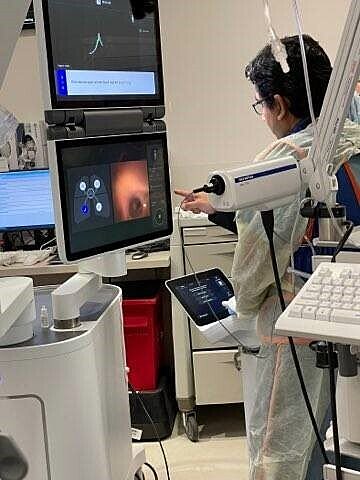Lung Cancer Awareness: Robotic Technology Streamlines Diagnosis

Lung cancer is the deadliest cancer, claiming a disproportionate number of lives compared with the next leading cancers combined: breast, prostate and colon. The absence of symptoms at onset and the ability for the disease to spread quickly and silently can lead to an advanced diagnosis.
“There is a substantial benefit of lung cancer screening,” said Hiren Mehta, MD, a professor of medicine in the University of Florida Division of Pulmonary Medicine. “The way lung cancer screening improves survival is by catching cancer at a much earlier stage, way before it starts spreading.”
Typically, when a patient is diagnosed with a suspicious nodule or mass in their lung, they are referred to a pulmonologist, who performs one or more lung biopsies, to confirm if it’s cancerous. This process can take some time, causing anxiety for the patient.
Now with robotic tools, physicians can quickly and safely access and biopsy difficult-to-reach nodules in the peripheral lung — where more than 70% of cancer lung nodules are located — streamlining diagnosis and treatment.
Streamlining patient care
Robotic-assisted bronchoscopy, or RAB, physicians can detect, accurately stage and diagnose lung cancer earlier. The innovative medical technology combines the precision and dexterity of robotic systems with bronchoscopy, a procedure used to examine the airways and diagnose lung conditions.
“Before the availability of robotic-assisted bronchoscopy, several modalities were used to diagnose lung cancer, including traditional bronchoscopy with biopsies, transthoracic biopsies as well as CT scans, PET scans and surgery,” Dr. Mehta said. “While these techniques remain essential, RAB adds a new dimension of precision and access to challenging areas of the airways.”
CT scans have been proven to save lives by detecting lung cancer early. However, they can also pick up on incidental nodules that are insignificant or smaller spots that require delays before a diagnosis can be made.
“It is not uncommon for patients with small lung cancer spots to be told to wait until the nodule grows more so the biopsy can be performed safely,” said Dr. Mehta, a member of the UF Cancer Center. “RAB can be especially beneficial for those with lesions in challenging or peripheral locations within the lung who would have otherwise been told to wait and get a follow-up scan.”
Waiting months between a biopsy and a diagnosis can be an emotionally taxing experience for patients. RAB can help reduce the anxiety and waiting times that patients sometimes experience.
“By diagnosing cancer early, it allows for early and curative treatment for lung cancer,” Dr. Mehta said.
What to expect
Robotic-assisted bronchoscopy is a same-day procedure with an expected duration of one to two hours and an additional hour for recovery. The patient is typically placed under general anesthesia to ensure comfort and immobility.
During the procedure, the physician uses a robotic system that consists of a flexible bronchoscope — a thin, lighted tube with tools and camera attached — guiding it to the spot on the lung to perform biopsies and even place markers for future treatments or surgeries. The physician guides the robotic arm, controlling the bronchoscope through a computer interface.
This leading-edge approach allows lung doctors to access and navigate airway passages with greater accuracy and control than previous methods. It’s unparalleled in its ability to deliver a comprehensive operation for a patient.
However, the procedure involves more than just a robot and physician. At UF Health, it takes a multidisciplinary collaboration to ensure patients receive the best care possible — a comprehensive lung cancer diagnosis and treatment — combining the expertise of specialists such as pulmonologists, anesthesiologists, radiologists, thoracic surgeons, medical and radiation oncologists and pathologists.
Are you a screening candidate?
The U.S. Preventive Services Task Force expanded its criteria for annual lung cancer screening. It recommends screening with low-dose CT, or LDCT, for adults who meet these criteria:
- 50 to 80 years old
- At least a 20 pack-year smoking history, which means one pack a day for 20 years (or two packs a day for 10 years, etc.)
- Current smoker or quit smoking within the past 15 years
Medicare and Medicaid cover annual screening for patients who meet the criteria.
This fall, the American Cancer Society, or ACS, weighed in, recommending an LDCT for anyone who has a significant smoking history regardless of when they quit, in its updated guideline, published in the CA: A Cancer Journal for Clinicians.
The cancer society’s updated screening guideline presents an opportunity to raise awareness around screening for lung cancer, especially those in Black and brown communities — where there is increased risk for developing and dying from lung cancer.
“My biggest piece of advice is that lung cancer screening saves lives,” Dr. Mehta said.
The UF Health Cancer Center is an NCI-designated Cancer Center and offers a comprehensive lung cancer screening program. Nine out of 10 lung cancer referrals are seen within seven days. This access to care is key to starting treatment early and giving patients the best chance for a cure.
Addressing stigma
As if a cancer diagnosis isn’t enough, lung cancer also carries stigma. Unlike others, its connection with smoking can be a powerful barrier to screening and early diagnosis.
“Patients sometimes feel like they did this to themselves, which can make them reluctant to get screened,” Mehta said. “At UF Health, we ensure each patient gets the individualized care they need.”
For help quitting tobacco, UF offers free in-person and virtual group classes. The best way to reduce a person’s risk of lung cancer is to quit smoking and stay smoke-free — it’s never too late to quit.
While smoking is the leading risk of lung cancer — linked to about 80% to 90% of lung cancer deaths — it is not the only one. Other risk factors include exposure to chemicals such as radon, other types of tobacco such as pipes or cigars, secondhand smoke and genetics. About 10% to 20% of people diagnosed with lung cancer never smoked.
